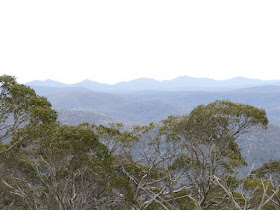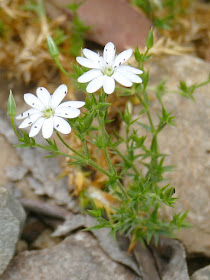The Brindabella Mountains form the western boundary of the Australian Capital Territory (ACT hereafter). They also form the northern end of the Australian Alps system; the 104,000 hectares of Namadgi National Park connect with Kosciuszko National Park to the west and south in New South Wales and thence to the Alpine National Park in Victoria further south. They are managed cooperatively by the relevant states and territory, with the federal government providing coordination to form one of the world's great national park systems, protecting some 16,500 square kilometres of montane, subalpine and alpine forests and heaths. They are also one of the best reasons to live here in Canberra, accessed by a sealed road just 50km from the city centre. The road continues as a good gravel road along the spine of the range, south for another 20km until it reaches a locked gate just past the short road up to the summit of Mount Ginini, which is the highest point of the ACT and provides the best drive-in view in the territory.
 |
| The Australian Alps national parks (courtesy of Wikpedia) with Namadgi National Park at the northern end. Mount Ginini is just to the north of Mount Bimberi, which is marked. |
On Sunday we drove up there to check the progress of the flowering. I've been taking people up there every December for over 30 years, and it is noticeable that the flowering has been getting steadily earlier during that time, to the point where peak flowering is probably now some two weeks ahead of where it was 30 years ago. Of course there are fluctuations in this from year to year and this year spring has been wet and cool so the timing this season is back to where it was in the past. One excellent indicator of this is the common understorey shrub, the pea Leafy Bossiaea Bossiaea foliosa, which appears in the foreground of the photo above (and more below); for the past decade or so it has finished flowering by December, which was very rarely the case in the past.
But first, a couple more 'scene-setters'; it is prevented from being a 360 degree view by the presence of an air navigation facility which blocks the vista to the north.
 |
| Looking west to the Bogong Peaks in northern Kosciuszko (not to be confused with Mount Bogong in Victoria). |
 |
| The view south-east (to the left of Mt Gingera in the earlier photo) to the mountains in the rugged southern wilderness of the ACT. |
The single highlight of the day was undoubtedly the bossiaea though, so here's some more of it!
 |
| Leafy Bossiaea dominated beneath the Snow Gums. |
 |
| The flowers are no more than 7mm long and the leaves are tiny. |
 |
| Big patches of yellow on Mount Gingera stained by the bossiaea. |
There were however plenty of other flowers to enjoy; here's a selection, starting with a couple more peas. I think for the most part they can speak for themselves.
 |
| Gorseleaf Bitterpea Daviesia ulicifolia. |
 |
| Common Shaggy-pea Oxylobium ellipticum; this is another that can be quite dominant, and like the bitterpea above, but unlike most of the other flowers shown here, it is also found at lower altitudes. |
 |
| Purple Eyebright Euphrasia collina.These delightful plants are hemiparasites on the roots of other herbs, and as a result are almost impossible to cultivate. |
Daisies are always prominent in the high country.
 |
| Spoon-leaf Daisy Brachyscombe spathulata. |
 |
| These Alpine Sunrays Leucochrysum alpinum were just starting to open. Until recently they were regarded as a subspecies of the widespread Hoary Sunray L. albicans. |
 |
| Showy Copperwire Daisy Podolepis jaceoides. This handsome daisy can form extensive meadows of gold. |
A couple of lilies.
 |
| Tasman Flax Lily Dianella tasmanica |
 |
| Rock Lilies Bulbine glauca, above and below, were just coming into flower. |
Just one orchid, but it's a favourite of mine.
 |
| Alpine Caladenia Caladenia alpina. |
 |
| buttercup Ranunculus lappaceus. |
 |
| Candles Stackhousia monogyna; another found at lower altitudes too. |
 |
| Black-eyed Susan Tetratheca bauerifolia. A delightful little herb whose down-pointing flowers can be challenging to photograph. |
 |
| Showy Violet Viola betonicifolia. This little beauty has a remarkable distribution from Tasmania to New Guinea and beyond into Asia, and from sea level to the Snow Gums. |
Of course there were many animals, but not many vertebrates; one however greeted us as soon as we pulled up.
 |
| Male Flame Robin Petroica phoenicea, with an unidentified snack. |
Surprisingly for a warm day we saw few reptiles, but one substantial one skittered across the road in front of us; it didn't stop to socialise, but here's one of the same species I prepared (a couple of years) earlier, in much the same place.
 |
| Blotched Bluetongue Tiliqua nigrolutea, one of a group of aberrant big skinks. |
The other animals were mostly here for the flowers too, especially the abundant butterflies. Local butterfly guru (gura?) Suzi Bond had given us a heads-up on the huge numbers of Rayed Blues Candalides heathi zipping everywhere, but they refused to sit still for posterity. Neither did the lovely Macleay's Swallowtails Graphium macleayanus, but they are too delightful not to share, so here's another photo from a previous visit to Mount Ginini.
 |
| Macleay's Swallowtail on Pimelea ligustrina. The hardy caterpillars browse on the fiery leaves of the Mountain Pepper. |
One butterfly which had no objection to being photographed was the common Australian Painted Lady Vanessa kershawi.
The bossiaeas attracted many insects, including this pretty little Concealer Moth Orthiastis hyperocha, family Oecophoridae (thanks Suzi and Ted!).
 |
| Concealer Moth on Leafy Bossiaea. |
 |
| These lovely green scarab beetles Diphucephala sp. are often found in large numbers on the bossiaeas. |
The Alpine Sunrays were a flower of choice for many insects, including these flies.
 |
| I'm afraid I can't help you with this fly, but I'd love to hear from you with any suggestions. |
 |
| A wasp (again unidentified, my invertebrate ignorance is embarrassing!) on the eyebright, which is an excellent insect attractor. |
I hope this has been enough to convince you that a visit to the mountains is a very good idea at this time of year (if you're in the Southern Hemisphere at least); if you're in my part of the world Mount Ginini would be an excellent choice, but don't leave it too long...
BACK
ON THURSDAY
(And remember that you can get a reminder when the next post appears by putting your
email address in the Follow by Email box in the top right of this screen.)
(And remember that you can get a reminder when the next post appears by putting your
email address in the Follow by Email box in the top right of this screen.)









The chances are that your hoverfly is Melangyna (Austrosyrphus) viridiceps. It is certainly subfamily Syrphinae. There aren't that many species in Australia (relatively speaking). I've opted for M. viridiceps based on the lack of yellow notopleural stripes and the presence of a black stripe on the face. This distinguishes it from the other likely suspect Simosyrphus grandiconis. However, my ID is fairly quick and dirty and based on how frequently these two Syrphinae species are recorded compared to others.
ReplyDeleteThe little black one on the daisy I won't hazard a guess at because I can't see the wing venation. There are too many possibilities to trawl through.
Why don't you think the next one is Tachinidae? Everything points that way to me (long face, colouration, wing venation). The long legs are a pointer to subfamily Dexiinae. Beyond that it would just be a guessing game for me. Without a specimen in the hand Tachinidae are really hard to ID without lots of practice.
Thanks Susan; as ever I value your knowledge and generosity. At my age I can't reasonably expect to become any sort of authority on inverts, but I do try and soak up things as and where I find them...
ReplyDelete